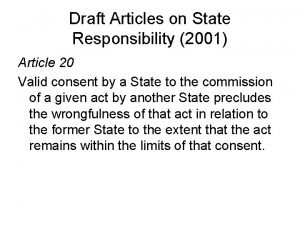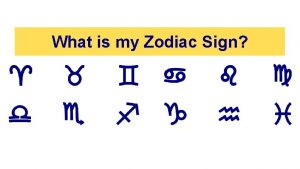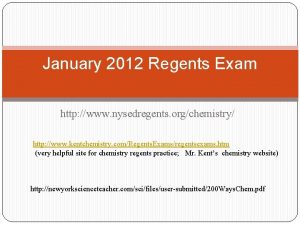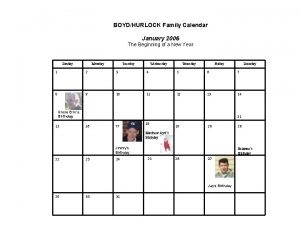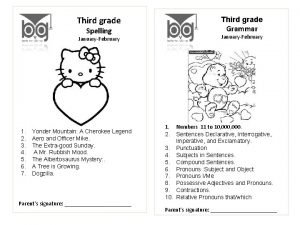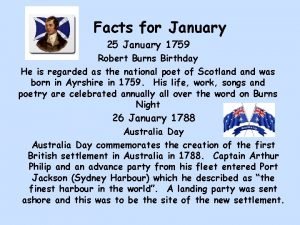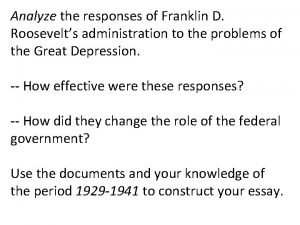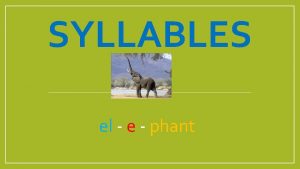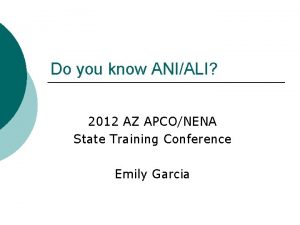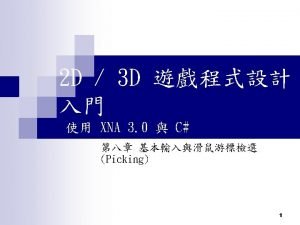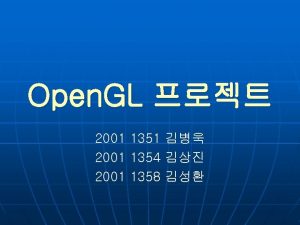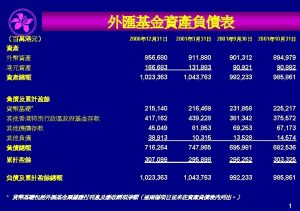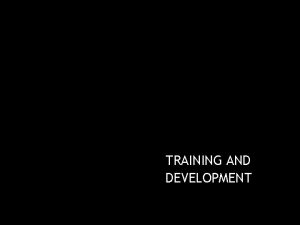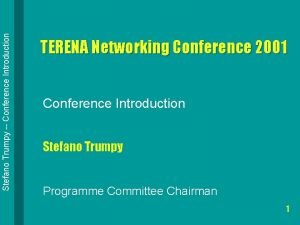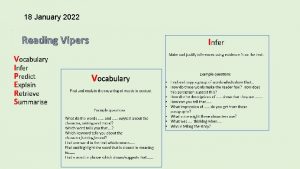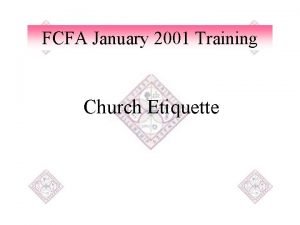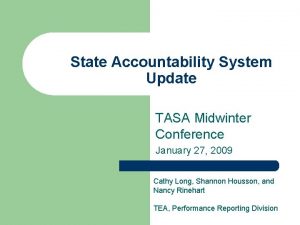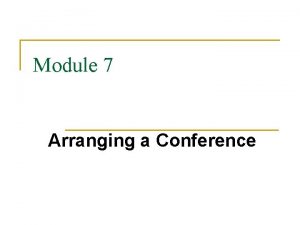2001 APCONENA State Training Conference January 19 2001



























- Slides: 27

2001 APCO/NENA State Training Conference January 19, 2001

An Antenna is : An effective interface between the radio and free space: Free space Radio Antenna For Terrestrial Communications, antennas must be a directional: Radio

Terrestrial Microwave Antennas for Point-To-Point Communication • Terrestrial microwave antennas generate a beam of RF signal to communicate between two locations. • Point-To-Point communication depends upon a clear line of sight between two microwave antennas. • Obstructions, such as buildings, trees or terrain interfere with the signal. • Depending upon the location, usage and frequency, different types can be utilized. • We will address the basic characteristics of these various types…

Electrical Performance Parameters Gain Cross-Polar Discrimination (XPD) Radiation Pattern Envelope Interport Isolation (IPI) Front to Back Ratio (F/B) Return Loss (VSWR)

Parabolic Antenna Directive Gain Ga (d. Bi) = 10 log 10 h [ 4 p Aa / l 2 ] Where: Ga = Antenna Directive Gain (Catalog spec) h = Aperture Efficiency (50 -55%) Aa = Antenna Aperture Area l = Wavelength (speed of light / frequency)

Typical Parabolic Antenna Gain in d. Bi Frequency Antenna Diameter

Radiation Pattern Concept Antenna Under Test Antenna Test Range Source Antenna

Radiation Pattern about Bore sight

Cut Through Radiation Pattern at Boresight

Front to Back Ratio • Ratio of the signal level at beam peak to that directed behind the antenna • Considered in intra-system interference calculation (hop overreach) • Expressed in d. B

Co-Polarization and Cross-Polarization • Co-Polarization Co-polarized antenna pattern – Where Transmit & Receive Antennas have the Same Polarization – In your System, The Wanted Signal • Cross-Polarization – Where Transmit & Receive Antennas have Different Polarizations – Either HV or VH. – In your System, The Unwanted Signal Relative Power – Either Horizontal or Vertical (HH or VV) XPD X-polarized patttern Azimuth Angle

Inter-port Isolation (IPI) Feed Horn Towards Reflector Transmit Signal Leakage Signal • Leakage of Signal Between Antenna Ports • Internal Noise • Expressed in d. B

Voltage Standing Wave Ratio (VSWR) Incident Signal Reflected Signal VSWR = 1 + (Reflection Coefficient) 1 - (Reflection Coefficient) • VSWR : 1. 30 Reflection Coefficient : 13% (0. 13) • VSWR : 1. 20 Reflection Coefficient : 9. 1% (0. 091) • VSWR : 1. 10 Reflection Coefficient : 4. 7% (0. 047) • VSWR : 1. 08 Reflection Coefficient : 3. 8% (0. 038) • VSWR : 1. 06 Reflection Coefficient : 2. 9% (0. 029)

Return Loss The Amount of Energy Lost due to Reflected (Returned) Signal RL = -20 x log (Reflection Coefficient) • RL : 17. 8 d. B Reflection : 13% (0. 13) VSWR : 1. 30 • RL : 20. 8 d. B Reflection : 9. 1% (0. 091) VSWR : 1. 20 • RL : 26. 7 d. B Reflection : 4. 7% (0. 047) VSWR : 1. 10 • RL : 28. 4 d. B Reflection : 3. 8% (0. 038) VSWR : 1. 08 • RL : 30. 7 d. B Reflection : 2. 9% (0. 029) VSWR : 1. 06

Basic Antenna Types Standard Parabolic Antenna Focal Plane Antenna Shielded Antenna GRIDPAK® Antenna

GRIDPAK® Antenna • Grid Reflector • Low Wind load • Single Polarized • Below 2. 7 GHz • Shipped in Flat, Lightweight Package

Standard Parabolic Antenna • Basic Antenna • Comprised of – Reflector – Feed Assembly – Mount

Focal Plane Antenna • Deeper Reflector • Edge Geometry • Improved F/B Ratio • Slightly Lower Gain

Shielded Antenna • Absorber-Lined Shield • Improved Feed System • Planar Radome • Improved RPE

Antenna Efficiency Well-designed antennas have efficiency ratings of 45 - 65% Efficiency Factor Affected By : • Feed Illumination • Aperture Blockage • Reflector Surface Tolerance Efficiency can never be 100%

Antenna f/D Ratio f f D f/D = 0. 333 Standard & Shielded Antennas D f/D = 0. 250 Focal Plane Antennas

Unwanted Signals Scattering Spillover Diffraction

Front to Back Ratio Direction of Signal Standard Parabolic Antenna Direction of Signal Focal Plane Antenna Direction of Signal Shielded Antenna

Parabolic Reflector Beamwidth 3 d. B Frequency Diameter Beamwidth in Degrees

Radiation Pattern Envelope 0 d. B down from Main Lobe Antenna Directivity 10 20 30 40 50 60 70 80 90 100 0 5 10 15 20 40 60 80 100 120 140 160 180 Azimuth - Degrees from Main Lobe

Radomes • Reduce Windloading on Tower • Protection Against Ice, Snow and Dirt

Other Antenna Options High XPD antennas Dual beam antennas Dual band antennas Low profile antennas Integrated antennas
 2001 draft articles on state responsibility
2001 draft articles on state responsibility Bi state primary care conference
Bi state primary care conference Bpa state leadership conference texas
Bpa state leadership conference texas He was born in salzburg austria on january 27 1756
He was born in salzburg austria on january 27 1756 Zodiac for january 20
Zodiac for january 20 Newton biography
Newton biography January february march april may
January february march april may January february march
January february march January 2017 chemistry regents answers
January 2017 chemistry regents answers January 2012 chemistry regents
January 2012 chemistry regents Nysedregents chemistry
Nysedregents chemistry Life of a plant poem by risa jordan
Life of a plant poem by risa jordan Ib physics hl grade boundaries
Ib physics hl grade boundaries Character traits of respect
Character traits of respect January 2006 calendar
January 2006 calendar January 27, 1756
January 27, 1756 Mozart was born in 1756
Mozart was born in 1756 January february spelling
January february spelling What is the theme for the month of january
What is the theme for the month of january Our sun life cycle
Our sun life cycle January 24 1848
January 24 1848 Meridel lesueur, new masses, january 1932.
Meridel lesueur, new masses, january 1932. Polytechnic hardware store
Polytechnic hardware store 25 january 1759
25 january 1759 An asset was purchased for $120 000 on january 1
An asset was purchased for $120 000 on january 1 Letter to senator robert wagner, march 7, 1934.
Letter to senator robert wagner, march 7, 1934. 1st january 2018
1st january 2018 Number of syllables in elephant
Number of syllables in elephant
